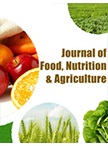Genotypes by environment effect on flowering and seed set in cassava, Manihot esculenta Crantz in Uganda
DOI:
https://doi.org/10.21839/jfna.2021.v4.7222Keywords:
GEI, AMMI analysis, flower initiation, cropping seasonAbstract
Cassava (Manihot esculenta Crantz) production has been constrained by biotic and abiotic factors, which could be solved by conventional breeding. However, cassava hybridization is difficult because many genotypes do not flower or set seeds and yet cassava sexual reproduction is essential for breeding programs. Consequently, this study was undertaken to identify agro ecologies in Uganda that best promote cassava flowering and seed set in order to facilitate breeding. Field evaluation of eight genotypes in randomized complete block design with three replications at three agro-ecologies of Uganda for two cropping seasons was conducted. Weather data were monitored and cassava flowering/seed set-related traits were collected at one-month interval commencing from 1.5 Months after planting. Results indicated that varieties previously categorized as high flowering and seed set performed differently than those identified as poor flowering and seed set, although with varying genotypic differences in each environment. Genotypes mean performances, additive main effect and multiplicative interaction and genotype main effect and genotype by environment interaction bi-plots model’ results indicated Rwebitaba in Western savannah grassland agro-ecology and Namulonge-NaCRRI in Lake Victoria Crescent agro-ecology as the most favorable environments for the performance of all the evaluated traits, and season one as the most favorable season. However, the most stable environment for all the evaluated traits was Abi-ZARDI. Conclusively, the high proportion of variation which occurred between genotypes and environments was explained by the genotypic variances. Dry months had poorer cassava flower initiation and development than wet months of the cropping season. Therefore, Abi-ZARDI in North-western savannah grassland agro-ecology and season one could be recommended for the establishment and timing of cassava breeding nursery.
Downloads
References
Alves, A. A. C. (2002). Cassava botany and physiology. Cassava: Biology, Production and Utilization, 67–89. http://doi.org/10.1079/9780851995243.0000
Beverley, J. G. (2007). Understanding Flowers and Flowering An Integrated Approach, Oxford University Press. http://doi.org/10.1017/CBO9781107415324.004
Ceballos, H., Iglesias, C. A., Pérez, J. C., & Dixon, A. G. O. (2004). Cassava breeding: Opportunities and challenges. Plant Molecular Biology, 56(4), 503–516. http://doi.org/10.1007/s11103-004-5010-5
Ceballos, H., Pérez Velásquez, J., Calle, F., Jaramillo O, G., Lenis Calderón, J., Morante, N., & López, J. (2002). A new evaluation scheme for cassava breeding at CIAT. Centro Internacional de Agricultura Tropical (CIAT), Cassava Office for Asia. Retrieved from https://cgspace.cgiar.org/handle/10568/56112
Chavarriaga-aguirre, P., & Halsey, M. (2005). Cassava (Manihot esculenta Crantz): Reproductive biology and practices for confinement of experimental field trials. Report prepared for the Program for Biosafety Systems. Washington, D.C: Program for Biosafety Systems.
Egesi, C., Cuambe, C., Rosero, A., Sanchez, T., Morante, N., Ceballos, H., & Fregene, M. (2007). Genetic Mapping Of Delayed Post-Harvest Physiological Deterioration In Cassava In Backcross Derivatives Of Manihot. In Abstract in PAGXVI San Diego, CA P6.
Farshadfar, E., Rashidi, M., Jowkar, M. M., & Zali, H. (2013). GGE biplot analysis of genotype × environment interaction in chickpea genotypes. European Journal of Experimental Biology, 3(1), 417-423.
Fernandez, G. C. J. (1991). Analysis of Genotype X Environment Interaction by Stability Estimates. Hortscience, 26(8), 947–950. https://doi.org/10.21273/HORTSCI.26.8.947
Fernandez-Pozo, N., Menda, N., Edwards, J. D., Saha, S., Tecle, I. Y., Stickler, S. R., Bombarely, A., Fisher-York, T., Pujar, A., Foerster, H., Yan, A., & Mueller, L. (2015). The sol Genomics Network (SGN)-From genotype to phenotypes to breeding. Nucleic Acids Research, 43, D1036-1041. https://doi.org/10.1093/nar/gku1195
Gauch, H. G. (1992). Statistical Analysis of Regional Yield Trials: AMMI analysis of factorial designs (pp. 278) Elsevier,New York.Chinese edition 2001.China National Rice Research Institute,Hangzhou, China.
Gauch, H. G. (2013). A simple protocol for AMMI analysis of yield trials. Crop Science, 53, 1860–1869. https://doi.org/10.2135/cropsci2013.04.0241
Gauch, H. G., Piepho, H. P., & Annicchiarico, P. (2008). Statistical analysis of yield trials by AMMI and GGE: further considerations. Crop Science, 48, 866–889. https://doi.org/10.2135/cropsci2007.09.0513
Howeler, R. (1996). Diagnosis of nutritional disorders and soil fertility maintenance of cassava. In G.T. Kurup, M. S. Polaniswami, V. P. Potty, G. Padmaja, S. Kabeerathumma and S.V. Pillaai, (Eds.), Tropical Tuber Crops: Problems, Prospects and future trategies, (pp. 181–193). New Delhi, India: Oxford and IBH Publishing Co. Pvt. Ltd.
Jaetzold, R., & Schmidt, H. (1983). Farm Management Handbook of Kenya, East Kenya (Eastern and Coast Provinces), Ministry of Agriculture, German Agency for Technical Co-operation (GTZ), Nairobi. Vol. II/C.
Jennings, D. L., & Iglesias, C. (2002). Breeding for Crop Improvement. Cassava: Biology, Production and Utilization, 149–166. http://doi.org/10.1079/9780851995243.0000
Jennings, L. D., & Hershey, H. C. (1992). Progress in breeding cassava for adaptation to stress. Plant Breeding Abstracts, 62(8), 823–831.
Keating, B. A., Evenson, J. P., & Fukai, S. (1982). Environmental effects on growth and development of cassava (Manihot esculenta Crantz.) I. Crop development. Field Crops Research, 5, 271–281. http://doi.org/10.1016/0378-4290(82)90030-2
Liu, T., Li, Y., Ren, J., Qian, Y., Yang, X., Duan, W., & Hou, X. (2013). Nitrate or NaCl regulates floral induction in Arabidopsis thaliana. Biologia, 68, 215-222. http://doi.org/10.2478/s11756-013-0004-x
Lynch, M., & Walsh, B. (1998). Genetics and Analysis of Quantitative Traits. Sunderland, MA: Sinauer Associates.
Miyazaki, Y., Maruyama, Y., Chiba, Y., Kobayashi, M. J., Joseph, B., Shimizu, K. K., & Satake, A. (2014). Nitrogen as a key regulator of flowering in Fagus crenata: Understanding the physiological mechanism of masting by gene expression analysis. Ecology Letters, 17(10), 1299–1309. http://doi.org/10.1111/ele.12338
Nunekpeku, W., Amoatey, H. M., Oduro, V., Klu, G. Y. P., Asare, D. K., & Danso, K. E. (2013). Study of the reproductive characteristics of nine cassava accessions. West African Journal of Applied Ecology, (2013); 21(1), 135–143.
Olasanmi, B., Akoroda, M.O., Egesi, C., Okogbenin, E., & Fregene, M. (2014). Cross-compatibility among six improved cassava (Manihot esculenta Crantz) varieties. Journal of Roots Crops, 40(1), 15-22.
PBTools. (2014). Biometrics and Breeding Informatics. PBGB Division. International Rice Research Institute Los Banos, Laguna.
Purchase, J. L., Hatting, H., & van Deventer, C. S. (2000). Genotype × environment interaction of winter wheat (Triticum aestivum L.) in South Africa: II. Stability analysis of yield performance. South African Journal of Plant and Soil, 17(3),101-107. http://dx.doi.org/10.1080/02571862.2000.10634878
Ravi, V., & Ravindran, C. S. (2006). Effect of soil drought and climate on flowering and fruit set in cassava (Manihot esculenta Crantz). Advances in Horticultural Science, 20(2), 147–150.
Schmalenbach, I., Zhang, L., Reymond, M., & Jiménez-Gómez, J. M. (2014). The relationship between flowering time and growth responses to drought in the Arabidopsis Landsberg erecta x Antwerp-1 population. Frontiers in Plant Science, 5, 609. http://doi.org/10.3389/fpls.2014.00609
Simwambana, M. S. C. (1993). Environmental factors modifying the growth and flowering behaviour of four cassava cultivars in Nigeria.
Shaff, B., Makler, K. A., Price, W. J., & Auld, D. L. (1992). Genotype X environment interaction effects on Winter Rapeseed yield and oil content. Crop Science, 32, 922-927. https://doi.org/10.2135/cropsci1992.0011183X003200040017x
USDA. (2002). U. S. Department of Agriculture. Field Book for Describing and Sampling Soils. Natural Resources Conservation Service, (Vol.33). https://doi.org/10.1111/j.1600 0587.2009.05973
Yan, W., & Kang, M. S. (2002). GGE Biplot Analysis: A Graphical Tool for Breeders, Geneticists and Agronomists. CRC Press, New York.






 .
.